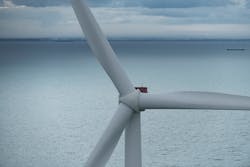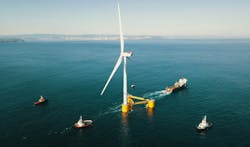WindFloat Atlantic represents major offshore wind milestone
Turbines said to be largest ever installed on floating platform
Bruce Beaubouef * Managing Editor
Installed in 100 m (328 ft) of water off the coast of Portugal, the WindFloat Atlantic project is widely regarded as a major milestone in the technological advancement of the offshore wind energy industry.
Developed by the Windplus consortium, the project consists of an array of three 8.4 MW MHI Vestas turbines, said to be the largest and most powerful wind turbines ever installed onto a floating foundation at sea. Each turbine operates on a Windfloat floating platform, an innovative design comprising a moored semisubmersible platform.
The Windplus consortium includes EDP Renewables, Engie, Repsol and Principle Power Inc. The 25-MW WindFloat Atlantic project is expected to generate enough electricity to supply the needs of 60,000 households for one year.
The installation of the first turbine on its floating platform took place in July 2019, in the Outer Harbour of Ferrol, Spain. In the following weeks, the platform proceeded to its final destination off the coast of Viana do Castelo (Portugal), where it was placed online in December. Fabrication of the next two platforms took place soon thereafter, and the third platform was placed online in July 2020. All three platforms now produce power which is transmitted through a 20-km (12.4-mi) export cable which links to the substation at Viana do Castelo.
The underlying innovation of the project was the semisubmersible floating foundation concept, which was based upon the design lessons learned by the offshore oil and gas industry. However, the design was adapted so that the platforms could support multi-megawatt wind turbines in offshore applications. Its stability is due to the use of water entrapment plates on the bottom of the three pillars, associated with a static and dynamic ballast system.
The project was advanced by a technical due diligence report completed by DNV GL in 2018. That report enabled the WindFloat Atlantic project to become the world’s first project-financed floating wind farm and secure an EU 60-million loan guaranteed by the European Investment Bank. In 2019, ABS classed the three semisubmersible platforms, which had been designed by Principle Power. ABS had certified a prototype semisubmersible floating offshore wind turbine, WindFloat 1, also designed by Principle Power, in 2011.
Project firsts
In addition to the use of the semisubmersible platform, the project represented a number of other firsts in the offshore wind energy industry:
- The largest and most powerful turbines ever installed on a floating structure
- First floating offshore wind farm off continental Europe
- First floating wind farm on the Iberian Peninsula
- First offshore wind energy structure designed to be capable of withstanding 17-m waves and winds of more than 60 knots.
In addition, each rotor is 164 m in diameter, double the size of the largest passenger airplane in the world. Each of the three WindFloat Atlantic platforms is 30 m (98.4 ft) tall with a 50-m (164-ft) distance between columns.
Design and construction
According to Repsol, WindFloat’s mooring technology allows for installation in waters of more than 100 m deep. The design is said to ensure stability in adverse weather and sea conditions. Repsol says that the model could be replicated in other areas where adverse seabed conditions or significant water depth rule out traditional bottom-fixed offshore wind technology.
A number of companies played key roles in the design and construction of the project. MHI Vestas was the turbine supplier, while Principle Power was the designer of WindFloat turbine foundations.
A joint venture of Navantia and Windar was contracted for the construction of one of the semisubmersible platforms in Avilés and Fene, Spain, while A. Silva Matos Group (ASM Industries) was contracted to construct the other two semisubmersibles in Setúbal, Portugal.
Bourbon Subsea Services was contracted for the offshore installation of the floating wind turbines and the mooring system, which was supplied by Vryhof Anchors. The mooring systems, which contained three sets of three mooring lines, were pre-laid in the first phase. The wind turbines were then towed to the offshore site and hooked up in a second phase, which also included the installation and hookup of the inter-array electrical cables.
Fugro provided positioning support for Bourbon’s offshore construction campaign, including support for the towing and positioning of the final floating wind turbine to the pre-installed anchor lines.
JDR Cable Systems was selected as the cable supplier for the project; and Trelleborg was subcontracted by JDR for the design and delivery of dynamic cable protection products for the project.
Project implications
As the offshore wind industry grows, it will need to develop floating concepts for its wind turbines, since there is a water depth limitation for fixed foundations; and wind resources tend to improve further out from the coastline. Meanwhile, wind turbines are increasing in size and weight. This also underscores the need for new floating wind concepts.
The WindFloat Atlantic project showed that floating offshore wind farms are feasible on a large scale, and are not subject to the same water depth restrictions as fixed structures. The floating technology may even provide an alternative to traditional bottom-founded technologies in intermediate water depths in the future.
The project also showed that companies that have traditionally operated in the offshore oil and gas marketplace can successfully transition to the offshore wind energy marketplace. These included not only Repsol, a partner in the Windplus consortium; but also Bourbon, Fugro, Trelleborg and JDR Cable Systems – all long-time players in the offshore oil and gas marketplace.
The offshore wind energy industry is progressing from “easier” and lower-cost shallow-water opportunities to the higher risk but potentially higher reward deepwater developments. This has interesting parallels to the evolution of offshore oil and gas development. But in the case of offshore wind, the transition is taking place in much shorter timeframe. Those parallels – and that condensed timeframe – present opportunities for companies that are well versed in the engineering, construction and installation of deepwater structures and facilities.
Editor’s Note: For more information, please attend Offshore’s upcoming Top Energy Transition Strategies webcast, which will be held on Dec. 15. It’s free to attend, simply register here.
About the Author
Bruce Beaubouef
Managing Editor
Bruce Beaubouef is Managing Editor for Offshore magazine. In that capacity, he plans and oversees content for the magazine; writes features on technologies and trends for the magazine; writes news updates for the website; creates and moderates topical webinars; and creates videos that focus on offshore oil and gas and renewable energies. Beaubouef has been in the oil and gas trade media for 25 years, starting out as Editor of Hart’s Pipeline Digest in 1998. From there, he went on to serve as Associate Editor for Pipe Line and Gas Industry for Gulf Publishing for four years before rejoining Hart Publications as Editor of PipeLine and Gas Technology in 2003. He joined Offshore magazine as Managing Editor in 2010, at that time owned by PennWell Corp. Beaubouef earned his Ph.D. at the University of Houston in 1997, and his dissertation was published in book form by Texas A&M University Press in September 2007 as The Strategic Petroleum Reserve: U.S. Energy Security and Oil Politics, 1975-2005.




